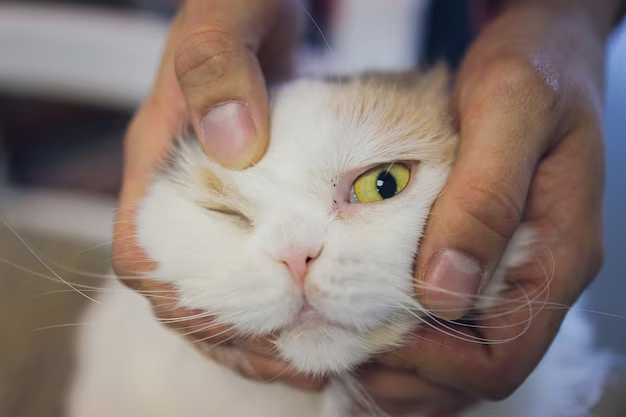Can Cats Develop Cataracts? Understanding Feline Eye Health
Is your furry feline suddenly bumping into things or shying away from sneaky movements? While cats are known for their sharp night vision and keen awareness, their eyes, much like ours, are not immune to certain ailments. One such condition you may have heard about in humans and dogs is cataracts. But do cats get cataracts too? Let's explore this intriguing question, uncovering the nuances of feline eye health along the way.
What Are Cataracts?
Cataracts occur when the lens of the eye becomes cloudy, leading to impaired vision. This cloudiness scatters light as it enters the eye, preventing a clear image from forming on the retina. In humans, cataracts are a common age-related condition, but cats have their own version of challenges when it comes to eye health.
How Cataracts Affect Vision
A cat with cataracts might experience blurry or dim vision, which can become more severe as the cataract progresses. While complete blindness is rare, substantial vision impairment can affect a cat's quality of life, making it harder to navigate their environment and potentially leading to changes in behavior.
Do Cats Get Cataracts?
The short answer is yes, cats can develop cataracts, although it's less common compared to dogs. Understanding the factors that contribute to cataract formation in cats helps in managing the condition effectively.
Causes of Cataracts in Cats
Age-Related Changes: Similar to humans, elderly cats are more susceptible to developing cataracts due to age-related degeneration.
Genetics: Certain breeds may have a predisposition to cataracts, including Himalayans and Persians.
Underlying Health Conditions: Conditions such as diabetes mellitus can lead to the formation of cataracts, as they affect the lens's normal metabolism.
Eye Trauma or Inflammation: Past injuries or ongoing inflammatory diseases can contribute to cataract development.
Nutritional Deficiencies: Proper nutrition plays a vital role in maintaining eye health, and deficiencies in key vitamins and minerals may predispose a cat to cataracts.
Signs Your Cat Might Have Cataracts
Cats are masters at hiding discomfort, so it’s crucial to look for subtle signs:
- Changes in eye appearance, such as a bluish or grayish tinge
- Difficulty navigating spaces, such as bumping into objects
- Changes in behavior, like increased caution or withdrawal
- Unusual eye movements or changes in pupil size
Diagnosing Cataracts in Cats
An early diagnosis can help be a game changer when it comes to managing cataracts in cats. Typically, a comprehensive eye examination by a veterinarian or veterinary ophthalmologist is required.
Steps to Diagnosis
- Visual Examination: Initial assessment of the eye’s appearance and reflexes.
- Ophthalmoscope Evaluation: Detailed examination of the lens and retina.
- Slit Lamp Examination: Assessment for cloudiness or opacities in the lens.
- Consideration of Medical History: Analysis of any underlying health issues that might contribute to cataract development.
Management and Treatment Options
Once cataracts are diagnosed, considering appropriate management and treatment options is crucial to enhancing and maintaining your cat's quality of life.
Non-Surgical Management
For minor cataracts that don’t impair vision significantly, conservative management might be recommended.
- Monitoring: Regular follow-up visits to monitor progression.
- Addressing Underlying Conditions: Effective management of diseases like diabetes that might contribute to cataract formation.
- Diet and Supplements: Ensuring your cat’s diet includes essential nutrients that support eye health.
Surgical Solutions
In cases where cataracts severely impair vision, cataract surgery may be an option. It involves removing the cloudy lens and possibly replacing it with an artificial one.
- Suitability: Not all cats are candidates for surgery; suitability is determined based on overall health, age, and specific eye conditions.
- Recovery and Aftercare: Post-surgery care includes medications and follow-up visits to ensure healing and adaptation.
Preventing Cataracts in Your Feline Friend
While not all cataracts can be prevented, several proactive measures can help reduce the risk or slow progression:
Eye Health Tips for Cats
- Regular Check-Ups: Routine veterinary visits to catch early signs of eye conditions or underlying diseases.
- Balanced Diet: Ensure a nutritious diet rich in antioxidants and essential fatty acids.
- Environmental Safety: Prevent eye injuries by maintaining a safe environment without sharp hazards.
- Grooming: Keep the eye area clean and free from debris, especially for long-haired breeds which are more prone to eye dirt build-up.
Quick Summary for Cat Owners 🐱
- Cats can get cataracts, though not as commonly as dogs.
- Key signs: Cloudy eyes, behavioral changes, or vision difficulties.
- Diagnosed through veterinary eye examinations involving sophisticated tools.
- Management includes monitoring, addressing underlying conditions, or surgery for severe cases.
- Prevention tips: Regular vet check-ups, a healthy diet, and a safe environment.
Adopting these measures can help create a quality living experience for your cat and ensure that their golden years are comfortable and fulfilling. Remember, attentive care goes a long way in safeguarding your cat’s health and happiness.
As you've seen, understanding whether cats can get cataracts unlocks a broader conversation about feline eye health. With regular care, the right balance of nutrients, and love, your cat can continue enjoying their playful and curious journey through life with you by their side.
